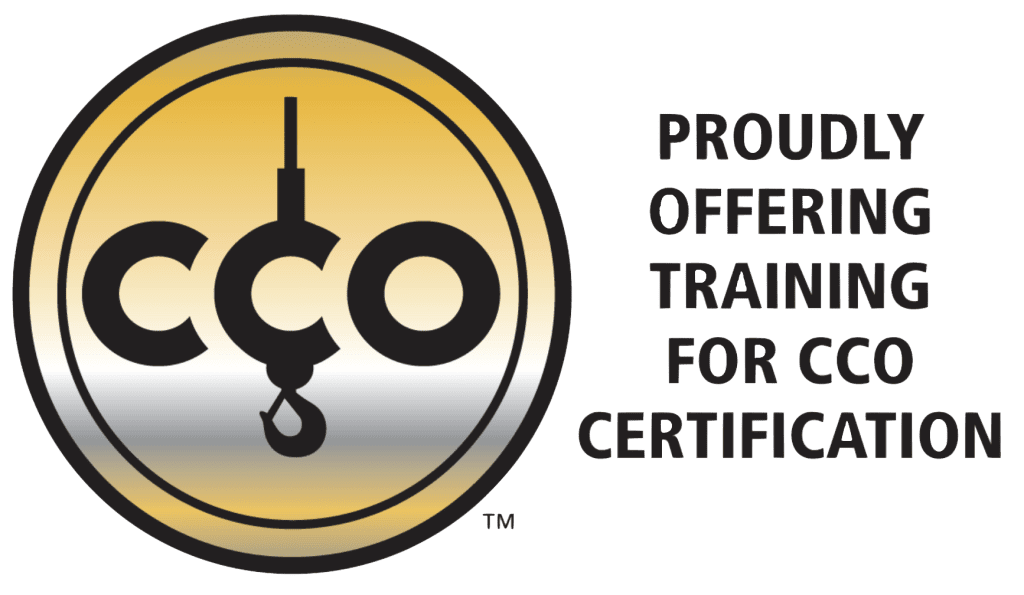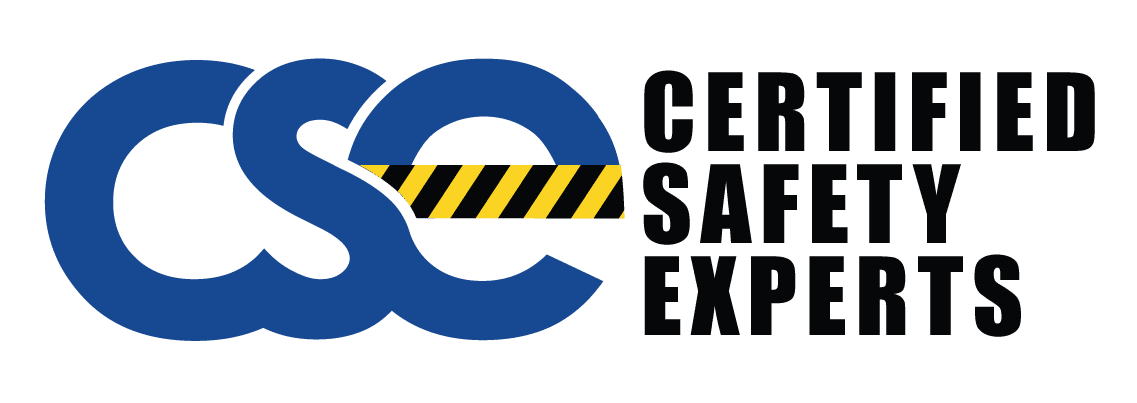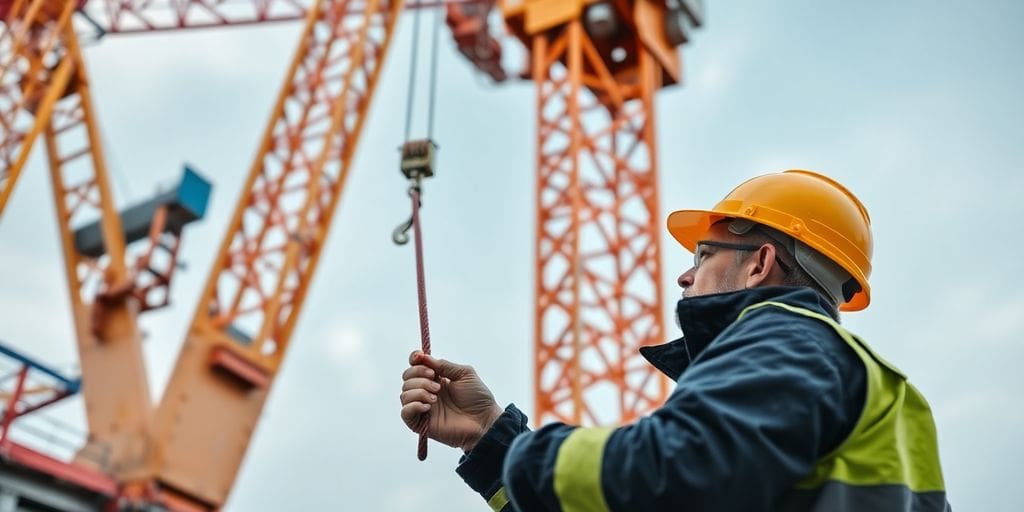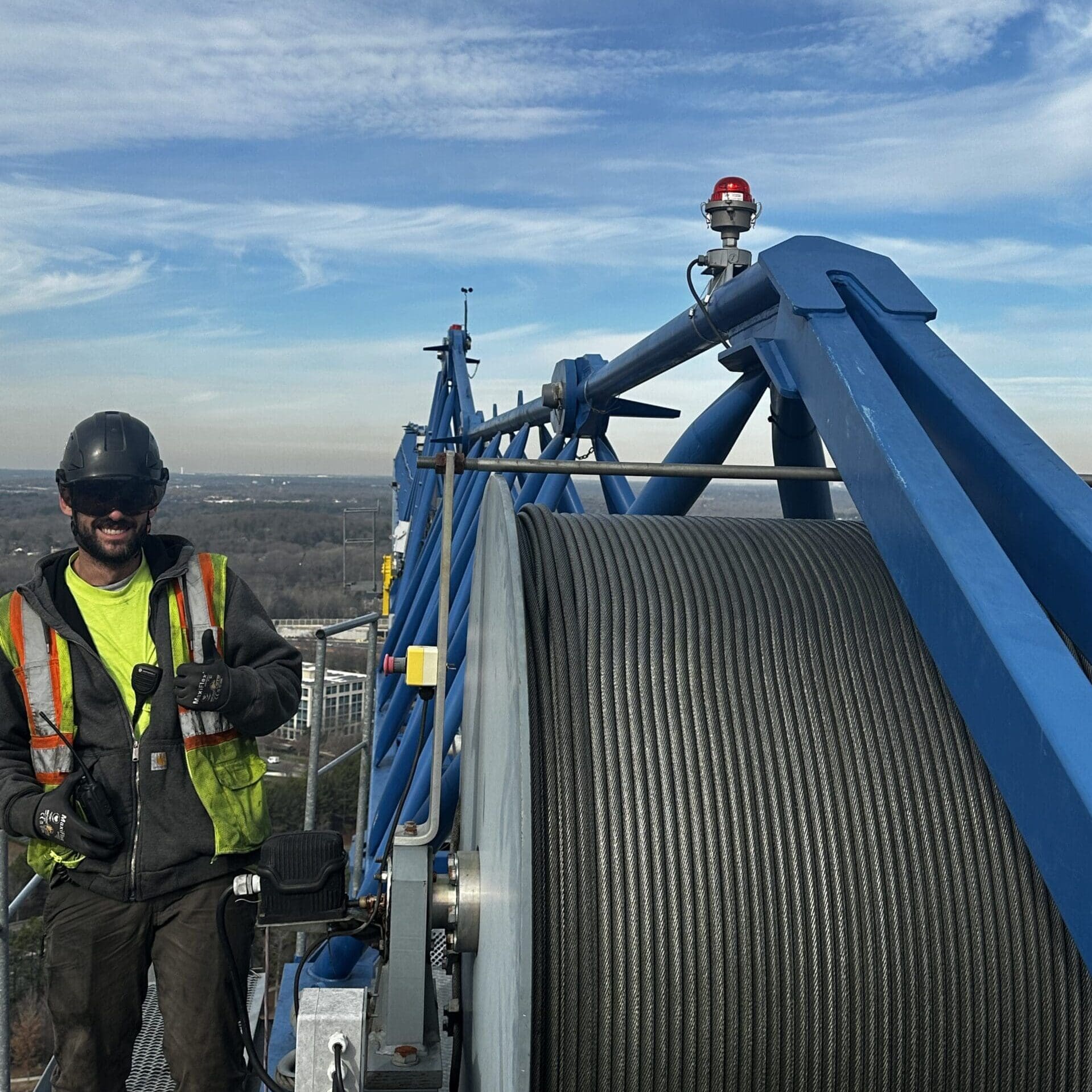Cranes are super useful on job sites, but let’s be real, they can also be pretty dangerous if not handled right. Thinking about how to prevent the most common accidents which occur when using cranes is a big deal for keeping everyone safe. We’re talking about things like tip-overs, loads falling, or even hitting power lines. It’s all about being prepared and knowing the right way to do things, from picking the crane to talking to the crew.
Key Takeaways
- Always pick the right crane for the specific job and make sure only trained, certified people are operating them.
- Before starting any work, do a thorough check of the crane every single day, including all the safety systems.
- Proper setup is a must – stabilize the crane correctly, especially with outriggers, and always check that the ground is solid and level.
- Learn how to rig loads securely and understand how sling angles and load radius affect the crane’s lifting ability.
- Never guess with weight limits; always check the load charts and plan for tricky lifts.
Choosing the Right Crane and Personnel
Picking the right crane and making sure you have the right people on board is step one for a safe job site. It’s not just about having a crane; it’s about having the correct crane for the specific task at hand. Cranes come in all shapes and sizes, from smaller carry deck cranes that are easy to move around to big crawler cranes that are great for softer ground. You’ve got rough-terrain cranes for bumpy sites and all-terrain cranes that can drive themselves to the job and handle tough spots once they get there. Choosing the wrong type can lead to all sorts of problems, so really think about what you’re lifting and where you’re doing it.
Select the Appropriate Crane for the Task
It sounds obvious, but picking the right crane is the first big safety move. Think about the weight you need to lift, how high you need to lift it, and the ground conditions. A crane that’s too small might struggle, and one that’s too big might be overkill and harder to maneuver. Different cranes are built for different jobs. For instance, if you’re working on uneven or soft ground, a crawler crane with its tracks is usually a better bet than a crane on rubber tires. Always check out the crane types and match them to your project’s needs.
Always Utilize Qualified and Certified Personnel
Having a qualified operator is non-negotiable. OSHA has rules about this, and for good reason. You need people who know what they’re doing, not just with operating the crane itself, but also with setting it up, rigging the loads, and signaling. This means operators should be trained, certified, and properly evaluated. Don’t guess on this; make sure everyone involved is up to snuff. It’s worth looking into resources that offer general safety tips for working with cranes, like those found at crane safety tips.
Thoroughly Review Operator Manuals
Even the most experienced operator needs to read the manual for the specific crane they’re using. Every crane is a little different, with its own controls, safety features, and quirks. The operator’s manual is packed with important info about:
- Load capacities
- Safety mechanisms
- How stabilizers and counterweights work
- Operator controls
Reading through it before you start is a must. It’s like getting to know your machine before you ask it to do heavy lifting. You wouldn’t drive a new car without checking out the dashboard, right? Same idea here, but with much higher stakes.
Daily Checks and Pre-Operation Inspections
Before you even think about lifting anything, a solid daily check and pre-operation inspection routine is your first line of defense against crane accidents. It might seem like a bit of a hassle, but trust me, it’s way better than dealing with the aftermath of a mishap. Think of it as giving your crane a quick once-over to make sure it’s ready for the day’s work.
Conduct Comprehensive Daily Operator Checks
This is where the operator really gets hands-on. It’s not just about starting the engine; it’s a detailed look at the crane’s condition. This includes checking things like:
- Tire pressure and condition (if it’s a mobile crane)
- Fluid levels (oil, coolant, hydraulic fluid)
- Seatbelt and general cab condition
- Horn and lights functionality
- Brake system and air reservoirs
A good checklist is your best friend here. It ensures nothing gets missed, no matter how routine the check might seem.
Perform Essential Safety System Checks
Beyond the basic mechanical checks, you’ve got to make sure the safety systems are actually working. These are the features designed to prevent serious problems. You’ll want to verify:
- The anti-two-block system is functioning correctly. This prevents the hook block from hitting the boom tip.
- The rated capacity limiter (RCL) is calibrated and operational. This system warns the operator if they’re approaching or exceeding the crane’s load capacity.
- All warning lights and alarms are active and responsive.
Verify Hydraulic System Integrity
Cranes rely heavily on hydraulics, so a healthy system is a must. This involves looking for:
- Any signs of leaks around hoses, fittings, and cylinders.
- Proper hydraulic fluid levels and condition.
- Smooth operation of all hydraulic controls without jerking or unusual noises.
Even minor hydraulic leaks can indicate a bigger problem brewing. It’s always better to address them before they lead to a system failure during a lift.
These checks might take a little extra time each day, but they are absolutely vital for keeping everyone on site safe and the operation running smoothly.
Safe Crane Setup and Stabilization
Setting up a crane properly is super important for keeping everyone safe. It’s not just about getting the boom up; it’s about making sure the whole machine is stable and ready for the job. Think of it like building a strong foundation for a house – if that’s shaky, nothing else will be safe.
Carefully Stabilize the Crane Before Rigging
Before you even think about attaching a load, you’ve got to get the crane stable. For mobile cranes, this usually means using outriggers or outrigger pads. These spread the weight out and stop the crane from tipping over. Always follow the manufacturer’s instructions on how far to extend them. It’s a common mistake to rush this step, but it’s one of the biggest reasons for accidents.
Ensure Proper Outrigger Placement and Support
When you’re placing those outriggers, make sure the ground underneath is solid. You don’t want them sinking into soft spots or resting over holes. Using outrigger pads is a must; they distribute the pressure over a larger area. If the ground isn’t perfect, you might need to bring in special mats or cribbing to create a stable base. It’s all about making sure the crane isn’t going to shift or sink once it’s under load. You can find more info on safe crane setup at OSHA’s crane page.
Verify Ground Conditions Are Solid and Even
This ties right into the last point. You need to be absolutely sure the ground can handle the weight. This means checking that it’s firm, level, and free of anything that could cause a problem, like underground pipes or cables. A quick visual check isn’t always enough; sometimes you need to do a bit more digging or probing to be certain. A stable base is non-negotiable for a safe lift.
Mastering Rigging and Load Handling
Rig Loads Correctly for Secure Lifting
Getting the rigging right is super important. It’s all about making sure whatever you’re lifting stays put and doesn’t fall. When you’re attaching slings to a load, think about the shape and how the weight is spread out. There are different ways to do this, like using a basket hitch or a choker hitch. Picking the right method depends on the item you’re lifting and how its weight is distributed. Proper rigging is your first line of defense against dropped loads.
Understand Sling Angles and Capacity
This is where things can get a little tricky, but it’s really key. When you don’t attach slings straight up and down (vertically), you actually put more stress on them. This means their lifting capacity goes down. So, if you’re lifting something that requires slings to be at an angle, you need to use slings that are rated for more weight than the actual load. Always check the sling’s capacity rating for the specific angle you’ll be using. It’s a good idea to have a chart handy that shows how sling capacity changes with different angles. You can find more info on proper rigging techniques here.
Grasp Load Radius and Its Impact
Understanding load radius is pretty much a game-changer for crane safety. Basically, the farther out the load is from the crane’s center, the less weight the crane can safely lift. Think of it like extending your arm – the farther out you hold something, the harder it is to keep it steady. The boom angle and any extensions on the crane really affect this. A higher boom angle means the load is closer, and the crane can handle more weight. A lower boom angle puts the load farther out, reducing its capacity. Always check the crane’s load chart to see what it can handle at different radii.
Adhering to Load Limits and Planning
Knowing your crane’s limits is super important for keeping everyone safe. It’s not just about lifting heavy stuff; it’s about understanding the forces at play and planning each move carefully. Always double-check the load chart before you even think about lifting. These charts are like the crane’s instruction manual for weight, and they tell you what the crane can handle in different situations.
Pay Close Attention to Load Charts
Load charts might seem a bit complicated at first, but they’re your best friend for safe lifting. They show you the maximum weight a crane can lift based on things like the boom length and angle. Remember, the further out the load is from the crane’s center (that’s the load radius), the less the crane can lift. It’s like trying to balance a long pole – the further out you hold something, the harder it is.
Understand Load Limits on Rubber vs. Outriggers
This is a big one. A crane can lift a lot more weight when its outriggers are properly deployed and supporting it, compared to when it’s just on its tires (on rubber). The load chart will have different columns for these scenarios, so make sure you’re looking at the right one. Using outriggers correctly is key to stability.
Develop Plans for Complex Lifts
What’s a complex lift? Generally, it’s when you’re lifting loads that are 80% or more of the crane’s capacity, or 50% if you’re on a barge. These lifts have a higher risk, so you absolutely need a detailed plan. This plan should cover everything from the rigging to the path the load will take. If you’re not sure, it’s always a good idea to get advice from experienced professionals or consider renting an operated crane. Having a solid plan helps prevent accidents, especially when dealing with tricky lifts. You can find more information on OSHA regulations regarding crane safety and test loads at OSHA crane regulations.
Navigating the Worksite Safely
Getting a crane around a busy job site can feel like a puzzle, but keeping things moving safely is totally doable with a little planning and awareness. It’s all about making sure the crane’s path is clear and that everyone on the ground knows what’s happening.
Avoid or Clear Obstacles During Travel
Before the crane even thinks about moving, someone needs to check the route. Are there materials stacked too high? Are there temporary structures in the way? Any potential obstructions need to be identified and either moved or marked clearly. For things that can’t be moved, like power lines, the crane needs to keep a safe distance. For example, OSHA says cranes need to stay at least 10 feet away from power lines that are 50,000 volts or less. A signal person should really be the crane operator’s eyes during travel, pointing out hazards and making sure other workers know the crane is coming through. It’s a team effort to keep that path clear.
Maintain Safe Access Routes for Cranes
This is where the controlling entity often steps in, making sure the paths cranes use are safe and clear. They’ll look for anything that could cause a problem, like uneven ground or debris, and make sure it’s sorted out before the crane starts its journey. It’s about creating a predictable and safe way for the crane to get from point A to point B without any surprises.
Coordinate Vehicle and Pedestrian Traffic
This part is super important for preventing those nasty surprises. When a crane is moving, especially a big mobile one, it’s got blind spots. The controlling entity, along with the signal person, helps manage all the other traffic. This means making sure other vehicles know to give the crane plenty of space and that any workers on foot are kept well away from the crane’s path. Clear communication and designated zones are key here. It’s about making sure everyone on the site knows where the crane is and where it’s going, so nobody accidentally wanders into a dangerous spot. You can find more about general crane safety guidelines at OSHA crane safety.
Keeping the worksite organized and everyone informed is the best way to avoid accidents when moving cranes. It’s not just about the operator; it’s about the whole team looking out for each other and the equipment.
Effective Communication and Hazard Awareness
Clear communication and knowing what’s going on around the crane are super important for keeping everyone safe. It’s not just about the operator; it’s about everyone on the site.
Use Proper Communication and Hand Signals
Having a standard way to talk to the crane operator is key. This means using the right hand signals or radios so everyone knows what’s happening. These signals tell the operator things like where to move the crane, when to lift or lower, and when to stop everything. It’s like a secret language for safety!
- Direction of travel
- Boom movement (up/down, swing)
- Load movement (hoist/lower)
- Stop/Emergency stop
Identify and Communicate Potential Hazards
Everyone on site needs to be aware of what could go wrong. This could be anything from power lines overhead to unstable ground or even just people walking nearby. It’s everyone’s job to spot these hazards and make sure the right people know about them. Think of it like being a lookout – if you see something risky, speak up!
Collaborate Effectively with Controlling Entities
Controlling entities, like site managers or safety officers, play a big role. They help make sure the site is safe before work even starts. This includes checking the ground, making sure there aren’t too many things in the way, and coordinating how vehicles and people move around the crane. They’re basically the safety coordinators for the whole operation, and working with them smoothly helps prevent a lot of problems.
Good communication means that everyone involved, from the crane operator to the ground crew and management, is on the same page about safety procedures and potential risks. This shared awareness is what stops accidents before they can happen.
Wrapping Up: Keeping Our Work Sites Safe
So, we’ve talked a lot about how to keep things safe when using cranes. It really comes down to a few main things: picking the right crane for the job, making sure only trained people are operating them, and always, always doing those daily checks. Don’t forget about setting up the outriggers right and rigging loads properly – those are big ones. Plus, knowing your load limits and using clear signals makes a huge difference. By paying attention to these details and working together, we can all help prevent accidents and make sure everyone goes home safe at the end of the day. It’s a team effort, for sure.
Frequently Asked Questions
Why is choosing the correct crane so important for safety?
Picking the right crane for the job is super important. Cranes come in different types, like those on tracks for soft ground or ones that can drive on roads and handle bumpy areas. You need to match the crane’s abilities to what the construction site is like and what you need to lift.
Do crane operators and workers need special training or certification?
Yes, everyone working with cranes needs to be trained and certified. This includes the operators, riggers, and anyone giving signals. OSHA, a government safety group, has rules that say only qualified people should work with cranes to prevent accidents.
What kind of checks should be done on a crane before using it each day?
Absolutely! Before you even start using a crane each day, the operator needs to do a thorough check. This involves looking at things like tires, oil, brakes, and important safety systems like alarms and limits. It’s like a daily health check for the crane.
How can I make sure a crane is stable and won’t tip over?
Making sure the crane is steady is key. Mobile cranes use outriggers, which are like legs that spread out. You need to put these on solid, level ground, using special pads underneath them. Never put them on soft spots or holes, as this can cause the crane to tip over.
What’s the big deal about load limits and understanding load charts?
You have to be really careful about how much weight you try to lift. Every crane has a load chart that tells you its limits. You also need to know how the angle of the crane’s arm and how far away the load is affect how much it can safely lift. Lifting too much is a major cause of accidents.
How does communication help prevent crane accidents on a job site?
Good communication is vital. This means using standard hand signals and sometimes radios so the operator knows exactly what to do. It’s also important to identify any dangers around the work area, like power lines or people, and make sure everyone knows about them. This helps prevent collisions or people getting hurt.
